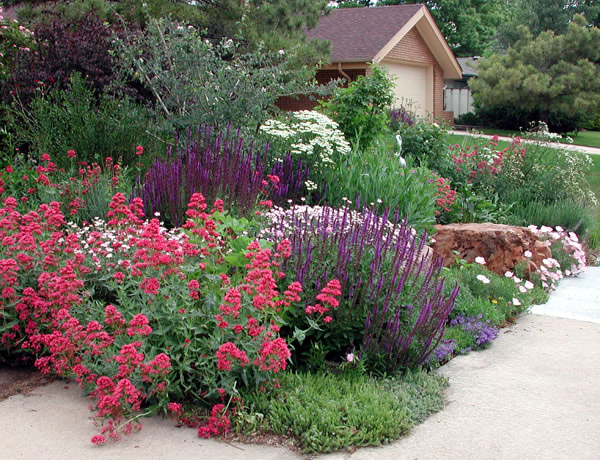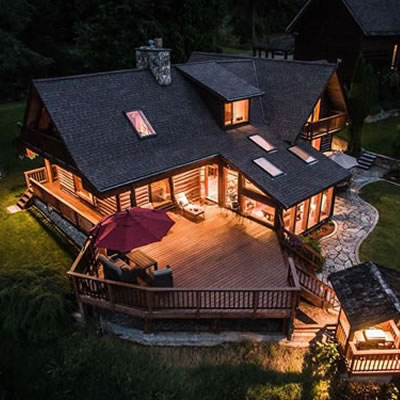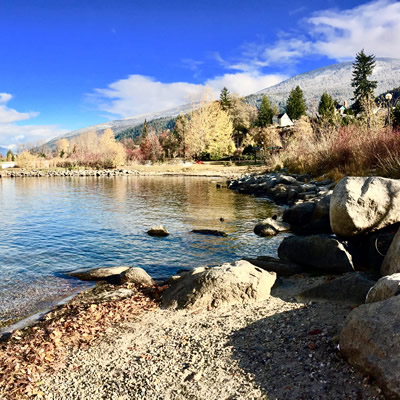Xeriscaping: You, me and the blue, part two
7 steps to make your landscaping as dry as a French malbec

Chris Holt, a professional xeriscaper and owner of Lakewood Landscaping, works with native and drought-resisitant plants to bring beauty and functionality to every yard. — Photo courtesy Chris Holt
Chris Holt’s interest and fascination with plants began in childhood—perhaps it was partly due to his mother telling him that plants were sensitive and had feelings too. That statement was a revelation, one which formed his lifelong approach to the plant world.
Holt is the owner of Lakewood Landscapes in Nelson, B.C., a full-service landscape and tree-care business serving the West Kootenay that specializes in the art of xeriscaping.
The practice
The principles of xeriscaping were developed in areas with limited precipitation. However, it has an ever-broadening appeal as water use becomes more restricted and expensive. The discipline is relatively new in the West Kootenay, particularly because the area is situated in the Interior Wet Belt. But summers often bring long periods of drought, and water supplies are often unable to keep up with the high demand.
“Landscape designers and landscape contractors must adapt accordingly,” said Holt. “My interest in water conservation has been guided by the needs of my clients. We are all affected by the overuse of what many have considered to be an endless resource.
“The term xeriscape is a modern hybrid word, which is a combination derived from the Greek ‘xeros’ (dry) and ‘scape’ from landscape,” said Holt. “Plants whose natural requirements are appropriate to an area’s climate are emphasized, and for this reason, plants indigenous to a given area are often recommended by landscape consultants and designers. Care is taken to avoid water loss due to evaporation and runoff.”
The principles
There are seven basic principles of xeriscaping.
The template: Planning and design play a big part in making your xeriscaping dream a reality. The basic aim of xeriscaping is water conservation. Landscape designers should look for ways to reduce the amount of applied water and reduce water loss through runoff and evaporation to maximize the use of natural precipitation.
From the ground up: Soil improvement can be achieved by incorporating organic material into the soil, allowing the soil to drain freely while retaining enough moisture for plant growth, having the soil tested by a reputable laboratory and using organic mulches.
Tough turf: Limiting turf areas to reduce the size of lawn areas as much as possible—but retaining some grass areas for family activities—also abides by the rules of xeriscaping.

Less water doesn’t have to mean less colour. Many plants conform to the xeriscaping code while still boasting colourful blooms. — Photo courtesy Chris Holt
Picking the right products: Plant choice can make or break your xeriscaping efforts.
“For best results, use indigenous plants,” Holt said. “You can also use drought-resistant plants that have thick, glossy leaves with fine hairs or a thick cuticle. They appear waxy. Plants with silver or grey leaves are often drought tolerant as well.”
Use trees, large shrubs and structures to block drying winds, which also provide shade for the smaller plants.
“Remember that drought-tolerant plants still need supplemental watering until well established in your garden” said Holt. “It can take a couple of growing season before they become fully drought-resistant. Also, avoid mixing plants with differing water requirements in the same
area.”
Adding water to the equation: Harvesting rainwater is a great complement to efficient irrigation systems. Roof catchment systems are the most simple and common method to harvest rainwater, employing gutters and downspouts to collect the rainwater. Screens on the gutters’ downspouts and rain barrels keep some debris out of the system.
Irrigate effectively: “Make sure to use efficient irrigation systems and practices when watering your property,” Holt said. “Irrigate early in the morning and avoid watering during the heat of the day to prevent evaporation. Avoid over- and under-watering by watering deeply and less frequently.”
Holt said that you can use drip or micro-jet irrigation systems. Overhead sprays make sure that there is head-to-head coverage.
Practice makes perfect: The final basic principle is cultural practices. Use slow-release fertilizers and apply them minimally. Aerate and dethatch lawns to improve water infiltration and reduce water runoff. Get rid of as many weeds as possible, as they use up precious water.
“Cut lawns high—particularly in the heat of summer,” said Holt. “The longer the
leaf blades, the deeper the roots and the higher the drought resistance.”
The pros and the cons
As with anything, there are advantages and disadvantages to xeriscaping.
Xeriscaping may require more preparation of garden beds before the planting begins, and in some neighbourhood’s people may object to the use of non-traditional plantings. A change of mindset may be difficult for some people moving from areas of high rainfall or those who are use to freer water consumption. Periodic maintenance may also require more skill and knowledge than just mowing a lawn.
However, the negatives are far outweighed by the positives when it comes to xeriscaping. Lower water bills, more water available for other uses and other people, and less maintenance are all advantages of this landscaping method. Your property will also require little to no mowing. Drought-tolerant plants, along with sound horticultural practices, tend to take full advantage of rainfall and increase habitats for beneficial insects, indigenous birds and other wildlife.
To get in touch with Chris Holt and bring a little magic into your own yard, email Lakewood Landscapes.






Comments